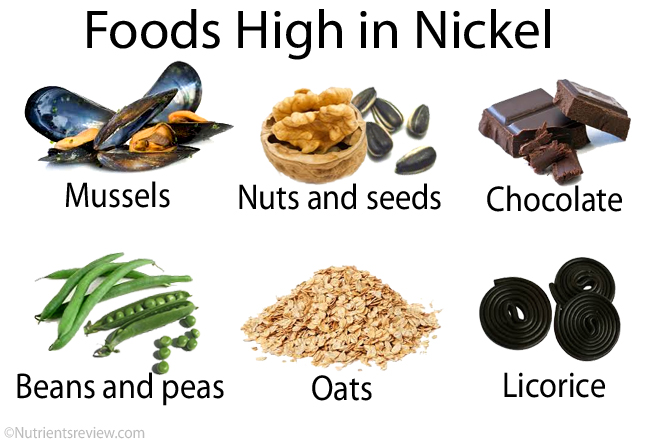- Nickel adverse effects National Academic Press
- Tolerable upper intake level for nickel National Academic Press
- Nickel Melisa Foundation
- Nickel function National Academic Press
Nickel
What is nickel?
Nickel is a mineral found in the human body, but its function and whether it is essential to human heath or life is not yet known [4].
Nickel Deficiency and Toxicity
Nickel deficiency or toxicity from dietary reasons are not known [1]. The estimated Tolerable Upper Intake Level (UL) for nickel for adults is 1 mg/day [2].
Picture 1. Examples of foods high in nickel
Foods High in Nickel and Nickel Allergy
Individuals allergic to nickel can reduce the possibility of allergic dermatitis by avoiding foods high in nickel [2,3]:
- Foods high in nickel (>0,5 mg/kg food) include mussels, nuts, seeds, beans, peas, soy flour, oatmeal, wheat bran, buckwheat, millet, dark chocolate, cocoa powder, liquorice.
- Moderate amounts of nickel (0,1-0,5 mg/kg food) are in oysters, milk chocolate, rice, rye, barley, kale, parsnips, garlic, raspberries.
Other foods that may trigger nickel allergy: margarine, acidic foods, such as stewed fruits or rhubarb, cooked in stainless steel utensils, tea from drink dispensers, beer, red wine, herring, mackerel, tuna, tomato, onion, carrots, apples, citrus fruits, dates, figs, pineapples, prunes.
Nickel Supplements
Nickel supplements containing nickel alone or nickel, zinc and cobalt, that “speed up chemical reactions in the body” or “are good for bones” can be found on the market, but there seems to be no serious studies that would prove their effectiveness.
Minerals
- Fructose
- Galactose
- Glucose
- Isomaltose
- Isomaltulose
- Lactose
- Maltose
- Mannose
- Sucrose
- Tagatose
- Trehalose
- Trehalulose
- Xylose
- Erythritol
- Glycerol
- Hydrogenated starch hydrolysates (HSH)
- Inositol
- Isomalt
- Lactitol
- Maltitol
- Mannitol
- Sorbitol
- Xylitol
- Fructo-oligosaccharides (FOS)
- Galacto-oligosaccharides (GOS)
- Human milk oligosaccharides (HMO)
- Isomalto-oligosaccharides (IMO)
- Maltotriose
- Mannan oligosaccharides (MOS)
- Raffinose, stachyose, verbascose
- SOLUBLE FIBER:
- Acacia (arabic) gum
- Agar-agar
- Algin-alginate
- Arabynoxylan
- Beta-glucan
- Beta mannan
- Carageenan gum
- Carob or locust bean gum
- Fenugreek gum
- Galactomannans
- Gellan gum
- Glucomannan or konjac gum
- Guar gum
- Hemicellulose
- Inulin
- Karaya gum
- Pectin
- Polydextrose
- Psyllium husk mucilage
- Resistant starches
- Tara gum
- Tragacanth gum
- Xanthan gum
- INSOLUBLE FIBER:
- Cellulose
- Chitin and chitosan
- FATTY ACIDS
- Saturated
- Monounsaturated
- Polyunsaturated
- Short-chain fatty acids (SCFAs)
- Medium-chain fatty acids (MCFAs)
- Long-chain fatty acids (LCFAs)
- Very long-chain fatty acids (VLCFAs)
- Monoglycerides
- Diglycerides
- Triglycerides
- Vitamin A - Retinol and retinal
- Vitamin B1 - Thiamine
- Vitamin B2 - Riboflavin
- Vitamin B3 - Niacin
- Vitamin B5 - Pantothenic acid
- Vitamin B6 - Pyridoxine
- Vitamin B7 - Biotin
- Vitamin B9 - Folic acid
- Vitamin B12 - Cobalamin
- Choline
- Vitamin C - Ascorbic acid
- Vitamin D - Ergocalciferol and cholecalciferol
- Vitamin E - Tocopherol
- Vitamin K - Phylloquinone
- Curcumin
- FLAVONOIDS:
- Anthocyanidins
- Flavanols: Proanthocyanidins
- Flavanones: Hesperidin
- Flavonols: Quercetin
- Flavones: Diosmin, Luteolin
- Isoflavones: daidzein, genistein
- Caffeic acid
- Chlorogenic acid
- Lignans
- Resveratrol
- Tannins
- Tannic acid
- Alcohol chemical and physical properties
- Alcoholic beverages types (beer, wine, spirits)
- Denatured alcohol
- Alcohol absorption, metabolism, elimination
- Alcohol and body temperature
- Alcohol and the skin
- Alcohol, appetite and digestion
- Neurological effects of alcohol
- Alcohol, hormones and neurotransmitters
- Alcohol and pain
- Alcohol, blood pressure, heart disease and stroke
- Women, pregnancy, children and alcohol
- Alcohol tolerance
- Alcohol, blood glucose and diabetes
- Alcohol intolerance, allergy and headache
- Alcohol and psychological disorders
- Alcohol and vitamin, mineral and protein deficiency
- Alcohol-drug interactions

